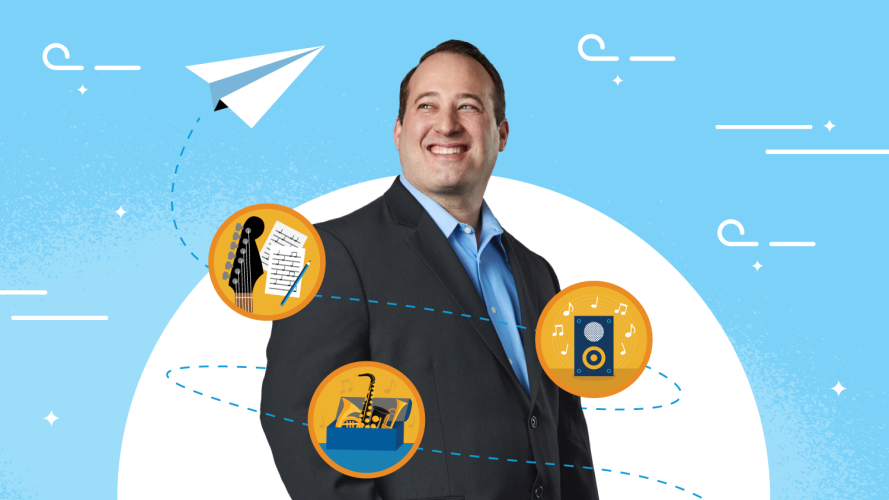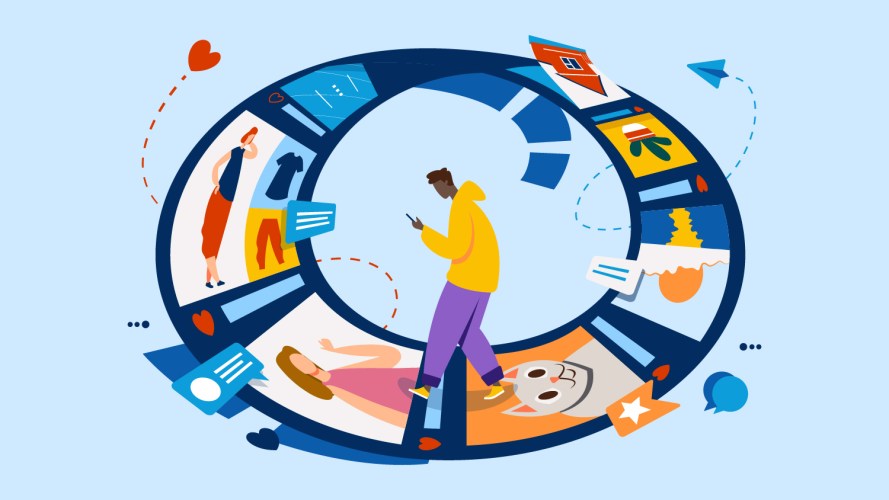How Demand Generation Marketing Helps You Win Over Customers



The competition is fierce and customers are choosy. Learn how you can connect with your audience and turn potential prospects into customers.

Nick Feldman
You can’t sell something to someone you don’t know exists yet, and they can’t buy anything from a company they’ve never heard of. Demand generation marketing (or “demand gen,” for short) means finding, learning about, and winning over potential customers. It’s about helping that person realize that your product helps solve their problems (when that happens, it’s called generating demand).
It’s not quite as easy as it sounds, so we’re here to make it simpler. There are plenty of obstacles between you and good demand generation marketing, but fortunately also plenty of ways to conquer them.
In this piece, we’re going to walk you through some of these challenges, the keys to overcoming them, the objectives and processes that fuel successful demand gen, and why good demand gen is worth the effort. Then we’ll show you what successful demand generation marketing looks like in the real world.
Think like a buyer and seal the deal
Use these four tactics to attract prospects, build lasting relationships, and deliver metrics that matter. Our latest B2B marketing guide will show you how.



What is demand generation marketing?
Demand generation marketing builds brand awareness, educates potential customers, and ultimately motivates them to interact with a brand. There are many ways to approach or think of demand generation marketing, but at its core it has five basic steps:
- Brand awareness and education: Make potential customers aware of your brand and product, and how they’re unique.
- Lead generation: Give those newly aware customers a reason to be curious about or interested in the brand, becoming “leads” in the process.
- Lead nurturing: Entice those leads to become more involved with the brand and more likely to purchase from it. You can do this through free content or gated assets the customer can get in exchange for sharing their information.
- Conversion: When a lead is properly nurtured, they start buying from your brand and become a customer.
- Tracking and data analysis: Learn from every conversion (and from failed conversion opportunities) to refine your demand generation approach and work toward more consistent results and higher conversion rates.
What are the marketing challenges of demand generation?
Demand generation faces a more crowded marketplace than ever before. Your competitors are all doing it too, so you need to find a way to stand out. The main challenge is keeping your customers’ and potential customers’ interest and attention focused on you — even as they’re inundated with lots of content.
Those customers also expect more and more from brands. Having so many options affords them the freedom to be choosy, and they tend to pick brands that can speak to them on a personal level.
Our State of the Connected Customer report found that 80% of customers say the experience a brand provides is just as important as its products or services. Additionally, our State of Marketing report found that 73% of customers expect companies to understand their unique needs and expectations.
So how do you guarantee those quality experiences to thousands or millions of people at a unique personal level? Your data is the key to overcoming both those challenges, but it’s also a challenge unto itself. With so many different streams active – web, email, social media, etc. – how do you sort, organize, and process all that incoming data in a way that’s easily accessible for your teams? How do you make sure everyone has access to the same data, and how do you make sure that data is correct?
Having a complete picture of your customer from all their various data streams is extremely valuable – to be frank, at this point it’s virtually a necessity for good demand generation. But creating that picture means being able to process a tremendous volume of incoming data very quickly, and being able to turn all that raw data into something easily digestible and useful for your teams.
Businesses also need to figure out where AI fits into their demand generation marketing approach. Your competitors are using it, so you need to figure out how to use it better than they do.
What are the key components of demand generation marketing?
Who, what, why, how, where, and when? The six most common questions in the English language are also the key components of good demand gen.
- Whom should you be targeting?
- What do they need, and why do they need it?
- How and where do you reach them (and how do you tell if it’s working)?
- When is it time to check back in, change up your approach, incorporate new technology, or jump on a trend?
The best way to answer these is with good data, audience segmentation, and targeting. Strong first-party data is best – that’s your potential customers (or “leads” in traditional demand gen parlance) themselves giving you the answers, but good market research and a good customer data platform can help you find them even in the absence of first party data.
Once you know who they are, you should segment them according to both their needs and your strategy. All your leads probably want something you offer, but they don’t all want the same thing (or respond to it the same way). Finding and sorting these prospects is usually called “lead generation.”
Once you’ve got your leads segmented out by who they are and what they want, the next step is targeting “why.” That’s also when you start answering your own “how.” No matter what they want or why they want it, the best way you’re going to help them realize you can give it to them is with quality content.
Your data, segmenting, and targeting should give you a pretty good idea of what they’re receptive to, so your responsibility is to make sure you’re making that content as compelling as possible. AI is a big player here, as it’s the key to helping you deliver timely, personalized content at scale.
“Where?” is about making sure that content reaches them in the right place. A good multi-channel marketing approach makes sure you reach your leads on the channels where they’re most responsive. From there, you move from lead generation to “lead nurturing.” This can mean different things to different businesses, but mostly it’s about taking a lead from being someone who’s aware of your brand to someone who’s actively buying from it. A good lead nurturing strategy makes all the difference in the world.
Finally, you get to your “when?” You should be making data-driven marketing decisions based on how your leads are responding to your demand generation marketing efforts, so you know exactly when to scale up or down, or if it’s time to try another tactic. You also want to make sure your sales and marketing teams are using the same platform, so when your leads are ready to become customers, the transition is smooth and efficient.
What are the key objectives of demand generation marketing?
The first thing you need your demand generation to do is increase awareness and visibility. Nobody can buy from your brand if they don’t know it exists, and even potential leads who may vaguely know who you are may not realize exactly what you offer.
Another major objective is generating and nurturing leads from that awareness. It’s not enough to simply make those leads aware of your brand, you want to motivate them to engage with it, and ultimately to convert.
Once you’ve got a consistent recipe to turn awareness into leads into conversion, your demand generation becomes one of your most powerful drivers of revenue. The right plan can help you convert unaware prospects into repeat customers that keep your business growing.
What is the demand generation process?
So how do you actually do demand generation marketing? Let’s dig a little deeper into those key areas from above:
- Step 1: Create brand awareness with your content marketing, thought leadership, and social media content. Use SEO best practices to help more potential leads find your content.
- Step 2: Generate leads through lead magnets, data analysis, landing pages, forms, webinars, and other events. Offer high-quality free content or gated assets in exchange for customers volunteering their information.
- Step 3: Nurture leads using targeted email marketing, personalized content, and scalable marketing automation tools. Use unified data and cross-functional platforms to help marketing and sales work in harmony.
- Step 4: Improve conversions and sales by optimizing your landing pages and user experience and by writing killer CTAs. You can use your data to implement intelligent lead scoring and qualification processes that make sure you only spend your resources on leads you can actually convert.
- Step 5: Track your results and improve your approach by identifying which metrics are most useful in evaluating your demand gen. And have a reliable process for adjusting based on what those results are telling you.
AI is a tool that can make every one of those steps easier and more effective. AI-driven personalization is the key to steps 1-3. AI lead scoring and data analytics drastically reduce the workload required to execute steps 4 and 5 effectively.
What are the benefits of demand generation marketing?
Following these basic guidelines and using the right automation tools makes demand generation marketing a powerful force that benefits your business up and down the funnel.
At the top of the funnel, good demand gen gives you a wider audience that’s more familiar with your brand, which quickly translates to greater market share.
Good lead generation helps fill up the middle of your funnel, while good lead nurturing makes sure they make it to the bottom. The personalized content and data-driven approaches you took on the way there help spark ongoing customer engagement and loyalty well beyond that first purchase.
All this adds up to more customers, more engagement, more conversions, and ultimately, a healthier business enjoying consistent, replicable growth.
Put your demand gen strategies to work
If your current technology only frustrates, it’s time to get one that automates. See how a marketing platform that makes good use of automation can help you create and maintain demand.






























